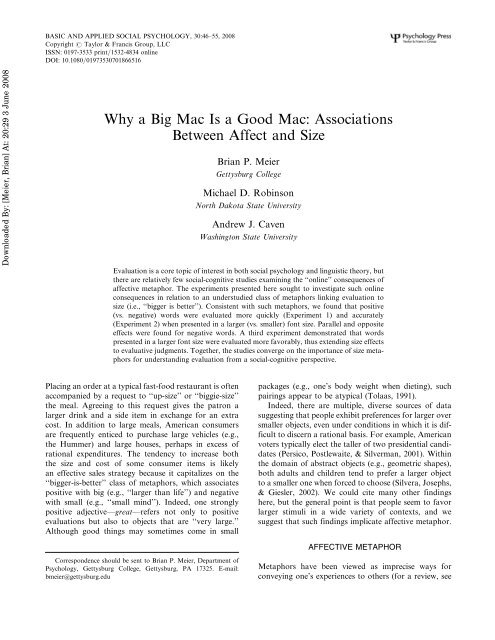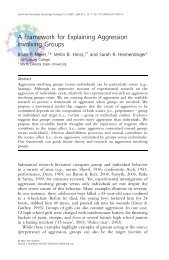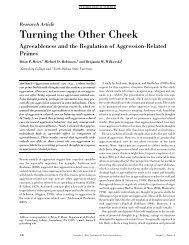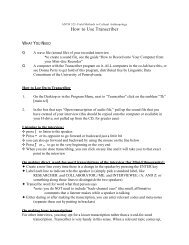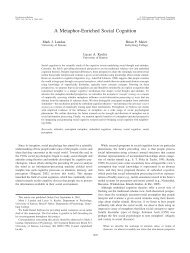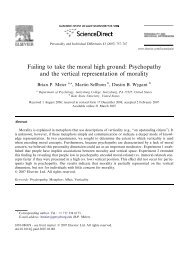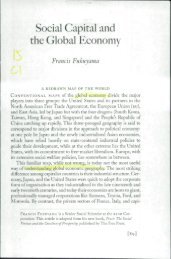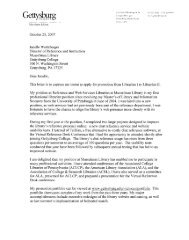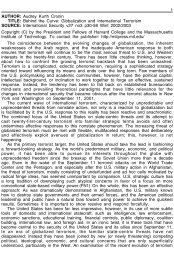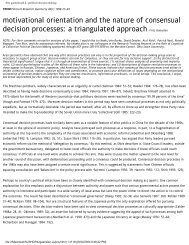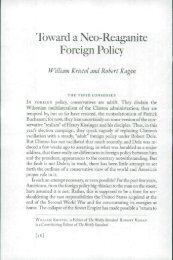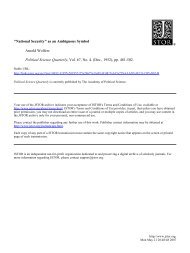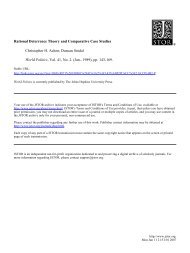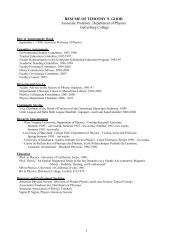Meier, Robinson, & C.. - Gettysburg College
Meier, Robinson, & C.. - Gettysburg College
Meier, Robinson, & C.. - Gettysburg College
Create successful ePaper yourself
Turn your PDF publications into a flip-book with our unique Google optimized e-Paper software.
Downloaded By: [<strong>Meier</strong>, Brian] At: 20:29 3 June 2008<br />
BASIC AND APPLIED SOCIAL PSYCHOLOGY, 30:46–55, 2008<br />
Copyright # Taylor & Francis Group, LLC<br />
ISSN: 0197-3533 print=1532-4834 online<br />
DOI: 10.1080/01973530701866516<br />
Why a Big Mac Is a Good Mac: Associations<br />
Between Affect and Size<br />
Brian P. <strong>Meier</strong><br />
<strong>Gettysburg</strong> <strong>College</strong><br />
Michael D. <strong>Robinson</strong><br />
North Dakota State University<br />
Andrew J. Caven<br />
Washington State University<br />
Evaluation is a core topic of interest in both social psychology and linguistic theory, but<br />
there are relatively few social-cognitive studies examining the ‘‘online’’ consequences of<br />
affective metaphor. The experiments presented here sought to investigate such online<br />
consequences in relation to an understudied class of metaphors linking evaluation to<br />
size (i.e., ‘‘bigger is better’’). Consistent with such metaphors, we found that positive<br />
(vs. negative) words were evaluated more quickly (Experiment 1) and accurately<br />
(Experiment 2) when presented in a larger (vs. smaller) font size. Parallel and opposite<br />
effects were found for negative words. A third experiment demonstrated that words<br />
presented in a larger font size were evaluated more favorably, thus extending size effects<br />
to evaluative judgments. Together, the studies converge on the importance of size metaphors<br />
for understanding evaluation from a social-cognitive perspective.<br />
Placing an order at a typical fast-food restaurant is often<br />
accompanied by a request to ‘‘up-size’’ or ‘‘biggie-size’’<br />
the meal. Agreeing to this request gives the patron a<br />
larger drink and a side item in exchange for an extra<br />
cost. In addition to large meals, American consumers<br />
are frequently enticed to purchase large vehicles (e.g.,<br />
the Hummer) and large houses, perhaps in excess of<br />
rational expenditures. The tendency to increase both<br />
the size and cost of some consumer items is likely<br />
an effective sales strategy because it capitalizes on the<br />
‘‘bigger-is-better’’ class of metaphors, which associates<br />
positive with big (e.g., ‘‘larger than life’’) and negative<br />
with small (e.g., ‘‘small mind’’). Indeed, one strongly<br />
positive adjective—great—refers not only to positive<br />
evaluations but also to objects that are ‘‘very large.’’<br />
Although good things may sometimes come in small<br />
Correspondence should be sent to Brian P. <strong>Meier</strong>, Department of<br />
Psychology, <strong>Gettysburg</strong> <strong>College</strong>, <strong>Gettysburg</strong>, PA 17325. E-mail:<br />
bmeier@gettysburg.edu<br />
packages (e.g., one’s body weight when dieting), such<br />
pairings appear to be atypical (Tolaas, 1991).<br />
Indeed, there are multiple, diverse sources of data<br />
suggesting that people exhibit preferences for larger over<br />
smaller objects, even under conditions in which it is difficult<br />
to discern a rational basis. For example, American<br />
voters typically elect the taller of two presidential candidates<br />
(Persico, Postlewaite, & Silverman, 2001). Within<br />
the domain of abstract objects (e.g., geometric shapes),<br />
both adults and children tend to prefer a larger object<br />
to a smaller one when forced to choose (Silvera, Josephs,<br />
& Giesler, 2002). We could cite many other findings<br />
here, but the general point is that people seem to favor<br />
larger stimuli in a wide variety of contexts, and we<br />
suggest that such findings implicate affective metaphor.<br />
AFFECTIVE METAPHOR<br />
Metaphors have been viewed as imprecise ways for<br />
conveying one’s experiences to others (for a review, see
Downloaded By: [<strong>Meier</strong>, Brian] At: 20:29 3 June 2008<br />
Gibbs, 1994). According to this view, metaphors are<br />
useful for communication but not involved in more<br />
‘‘online’’ processes related to perception and judgment.<br />
A second view has challenged such ideas by claiming that<br />
metaphoric-representation processes are used in encoding<br />
new stimuli and therefore central to online representational<br />
processes (e.g., Gibbs, 1994; Lakoff & Johnson,<br />
1999). Much of this debate has been framed in terms of<br />
philosophical–linguistic arguments, but the ultimate<br />
arbiter of such debates should be empirical data targeting<br />
online encoding and judgment processes (Gibbs, 1994).<br />
Metaphor-representation processes seem to be particularly<br />
important in the domain of affect and evaluation,<br />
presumably because affect is a fairly abstract<br />
concept that is nevertheless very important to daily life<br />
(Lakoff & Johnson, 1999). In support of this point,<br />
people have many affective metaphors, including those<br />
related to verticality, lightness–darkness, and physical<br />
proximity to an object (Lakoff & Johnson, 1999; <strong>Meier</strong><br />
& <strong>Robinson</strong>, 2005). Moreover, we have shown in several<br />
studies that task-irrelevant physical attributes, such as<br />
those related to the lightness–darkness (e.g., <strong>Meier</strong>,<br />
<strong>Robinson</strong>, & Clore, 2004) or vertical location (e.g.,<br />
<strong>Meier</strong> & <strong>Robinson</strong>, 2004) of stimuli, bias evaluations<br />
in a metaphor-consistent direction. For example, we<br />
have shown that positive words are evaluated faster<br />
when presented in a lighter font color, whereas negative<br />
words are evaluated faster when presented in a darker<br />
font color (<strong>Meier</strong> et al., 2004). Such data appear to<br />
support the point that evaluative judgments are faster<br />
when consistent with affective metaphor (see <strong>Meier</strong> &<br />
<strong>Robinson</strong>, 2005, for a review).<br />
Our prior studies, however, are limited in a few<br />
respects. Metaphors linking affect to verticality (e.g.,<br />
‘‘two thumbs-up’’ ) and stimulus color (e.g., ‘‘I’m in a<br />
dark place’’) are relatively strong and ubiquitous (e.g.,<br />
Lakoff & Johnson, 1999). Metaphors linking affect to<br />
stimulus size are less pronounced in nature. Along these<br />
lines, ‘‘good things can come in small packages’’ and<br />
body weight is typically evaluated more favorably<br />
when it is lower. Accordingly, our focus on stimulus<br />
size manipulations is both entirely novel and important<br />
to extending the empirical case for the metaphorrepresentation<br />
perspective (Gibbs, 1994).<br />
Indeed, it is useful to contrast two different views of<br />
affective metaphor. One view links it to the specific<br />
phrases typical of a language (for a review, see Gibbs,<br />
1994). A second view links affective metaphor to ‘‘deeper’’<br />
mappings that motivate and guide specific linguistic<br />
metaphors (Lakoff, 1987; Lakoff & Johnson, 1999).<br />
Our focus on stimulus size is useful because it allows<br />
us to dissociate these levels of analysis to a greater extent<br />
than in our previous studies (e.g., <strong>Meier</strong> & <strong>Robinson</strong>,<br />
2004; <strong>Meier</strong> et al., 2004). Specifically, linguistic associations<br />
linking higher positions and lighter stimuli to<br />
ASSOCIATIONS BETWEEN AFFECT AND SIZE 47<br />
positive evaluations are especially prevalent in the<br />
English language (<strong>Meier</strong> & <strong>Robinson</strong>, 2005), whereas<br />
this appears to be less true in relation to stimulus size<br />
(Lakoff & Johnson, 1999). Accordingly, demonstrating<br />
evaluative biases related to stimulus size might provide<br />
better evidence for the idea that such effects pertain to<br />
‘‘deeper,’’ prelinguistic associations of the sort discussed<br />
by Lakoff (1987).<br />
In addition to examining the novel issue of whether<br />
stimulus size biases evaluations, we also examined a<br />
number of other issues important to the social-cognition<br />
literature on evaluation. Evaluations can be more or less<br />
automatic in nature (Tesser & Martin, 1996), and it is<br />
important to use procedures suited to examining automatic<br />
evaluations in work of this type (Fazio & Olson,<br />
2003). Accordingly, we conducted an experiment in<br />
which evaluations had to be made particularly quickly,<br />
specifically through the use of a ‘‘response-deadline’’<br />
procedure, which is typically used to establish the automatic<br />
basis of an effect (Draine & Greenwald, 1998). If<br />
stimulus size biases evaluations in this paradigm, we can<br />
be more certain that the effects are automatic according<br />
to conventional social-cognition criteria.<br />
THE CURRENT EXPERIMENTS<br />
In Experiments 1 and 2, we examined the effect an irrelevant<br />
manipulation of physicality—here, related to font<br />
size—on the speed (Experiment 1) and accuracy (Experiment<br />
2) with which participants could evaluate positive<br />
and negative words. In both studies, we predicted an<br />
interaction such that positive evaluations would be<br />
facilitated by a larger font size, whereas negative evaluations<br />
would be facilitated by a smaller font size. However,<br />
findings along these lines might have uncertain<br />
relevance to evaluative judgments, which are arguably<br />
more important from a social-cognitive standpoint<br />
(Tesser & Martin, 1996). Accordingly, Experiment 3<br />
sought to significantly extend our prior work by examining<br />
effects of a task-irrelevant manipulation of font size<br />
on evaluative judgments. On the basis of the metaphorrepresentation<br />
perspective, we predicted that larger (neutral)<br />
words would be evaluated more favorably than<br />
smaller (neutral) words. Findings along these lines would<br />
bridge the gap between cognitive and social-cognitive<br />
studies of affective metaphor, and would additionally<br />
make the important point that affective metaphor has<br />
significant implications for evaluative judgments.<br />
EXPERIMENT 1<br />
In Experiment 1, we presented positive and negative<br />
words in either larger or smaller font sizes, and
Downloaded By: [<strong>Meier</strong>, Brian] At: 20:29 3 June 2008<br />
48 MEIER, ROBINSON, CAVEN<br />
participants were asked to evaluate these words. Because<br />
the font size manipulation was independent of the<br />
manipulation of stimulus valence, participants should<br />
not be influenced by it, according to rational considerations.<br />
However, if people make evaluations in a manner<br />
consistent with the metaphor-representation perspective,<br />
then positive evaluations should be faster for larger<br />
words and negative evaluations should be faster for<br />
smaller words.<br />
Method<br />
Participants<br />
Participants were 32 undergraduate volunteers (4 male)<br />
with an average age of 24.28 (SD ¼ 8.20) years. Thirty<br />
participants were White (93.8%) and 2 participants were<br />
Asian (6.3%).<br />
Materials<br />
Positive and negative words. We used 100 words,<br />
50 of which had a positive meaning (e.g., kiss) and 50<br />
of which had a negative meaning (e.g., dead). The<br />
average number of letters per word was similar for each<br />
valence, F < 1. A pilot test also confirmed that the<br />
positive words (M ¼ 7.46, SD ¼ .86) were rated (from<br />
1[very negative] to9[very positive]) more positively than<br />
the negative words (M ¼ 2.42, SD ¼ .70), F(1, 98) ¼<br />
1040.44, p < .001, g2 p ¼ :91 but that they were equally<br />
extreme, defined in terms of the absolute difference from<br />
the midpoint of the evaluation scale, F < 1. However, as<br />
is typical (e.g., Dixon, 1981), our positive words were<br />
a bit more frequent in the English language than our<br />
negative words, F(1, 98) ¼ 3.83, p ¼ .053, g2 p ¼.04. We<br />
were not concerned with this difference because it could<br />
not compromise our interactive predictions. 1<br />
Procedure<br />
The 100 words were presented in the center of a computer<br />
screen one at a time. The words randomly<br />
appeared in 20.5-point or 15.5-point Times New Roman<br />
font (in white color on a black background). Word type<br />
and font size were chosen at random by a computer<br />
program, which resulted in each participant receiving<br />
approximately half of the words in the larger font size<br />
and the other half in the smaller font size (each participant<br />
received a different set of words in each font size).<br />
Participants were told that the task was concerned<br />
with their ability to evaluate words regardless of<br />
possible changes in appearance. To make evaluations,<br />
participants were asked to press the Q key on the<br />
1<br />
Stimuli for Experiments 1 and 2 were identical to those reported<br />
in <strong>Meier</strong> and <strong>Robinson</strong> (2004).<br />
keyboard for positive words and to press the P key on<br />
the keyboard for negative words. To help participants<br />
remember this mapping, the labels ‘‘Q ¼ POSITIVE’’<br />
and ‘‘P ¼ NEGATIVE’’ were placed on the bottom of<br />
the screen in 18-point Times New Roman font. The<br />
word remained on the screen until participants made a<br />
response. Participants were told to be quick and<br />
accurate. If participants were inaccurate, the word<br />
INCORRECT appeared in red font for 1.5 sec. Correct<br />
responses were followed by a 300-msec blank screen.<br />
Results<br />
We dropped inaccurate categorizations (4.4% of trials),<br />
log-transformed latencies to reduce skew, and replaced<br />
2.5 SD RT-outliers with these cutoff values (see<br />
<strong>Robinson</strong>, 2007, for a methodological discussion).<br />
Log-transformed latencies were examined, but effects<br />
are reported in milliseconds. Descriptive statistics for<br />
all variables in all experiments are reported in Table 1.<br />
We performed a 2 (valence: positive or negative) 2<br />
(size: big or small) repeated measures analysis of variance<br />
on evaluation latencies. The main effect of valence<br />
was significant, F(1, 31) ¼ 4.56, p ¼ .041, g2 p ¼.13,<br />
which indicated that participants were faster to evaluate<br />
positive (M ¼ 962 msec, SD ¼ 170 msec) relative to<br />
negative (M ¼ 1,000 msec, SD ¼ 205 msec) words. The<br />
main effect of size was not significant, F < 1. Of most<br />
importance, the Valence Size interaction was significant,<br />
F(1, 31) ¼ 5.54, p ¼ .025, g2 p ¼.15, and the means<br />
for this interaction are shown in Figure 1.<br />
Given the main effect for valence, which was<br />
expected, it was not legitimate to compare valence<br />
effects for a given font size. However, given the lack<br />
of a main effect for font size, it is more informative to<br />
compare font size effects for each word valence considered<br />
separately. In the latter simple comparisons, it<br />
was found that participants were faster to evaluate positive<br />
words if they were presented in the larger (vs. smaller)<br />
font size, F(1, 31) ¼ 5.28, p ¼ .029, g2 p ¼.15, whereas<br />
there was an opposite trend in evaluation times for negative<br />
words, F(1, 31) ¼ 2.56, p ¼ .120, g2 p ¼.08. Although<br />
the latter simple effect was not significant at the traditional<br />
level, the crossover interaction clearly highlights<br />
the divergent effects of font size for positive versus<br />
negative evaluations.<br />
Discussion<br />
Experiment 1 manipulated font size and found that positive<br />
words were evaluated more quickly when presented<br />
in a large font size, whereas negative words were evaluated<br />
more quickly when presented in a small font size.<br />
This interactive pattern is entirely novel and supports<br />
the idea that stimulus size is used as a heuristic to
Downloaded By: [<strong>Meier</strong>, Brian] At: 20:29 3 June 2008<br />
TABLE 1<br />
Means, Standard Deviations, and Internal Consistencies for the Variables Assessed in all Experiments<br />
stimulus valence at encoding. Because this interactive<br />
pattern is consistent with affective metaphor, we suggest<br />
that Experiment 1 offers initial evidence for the idea<br />
that size is used as an online heuristic when making<br />
evaluations.<br />
However, we also point out that affective metaphors<br />
related to stimulus size may be less pervasive than those<br />
related to other factors such as stimulus brightness<br />
(Kövecses, 2000). We regard this as an important context<br />
for our findings in the sense that, although linguistic<br />
associations linking size and affect may be less robust<br />
relative to other linguistic associations, the ‘‘deeper’’<br />
mappings linking size and affect may nevertheless be<br />
quite robust (Lakoff, 1987). In other words, affective<br />
links between size and evaluation may precede and<br />
motivate linguistic associations (Lakoff, 1987).<br />
In support of this prelinguistic theory, Tolaas (1991)<br />
suggested that links between evaluation and size develop<br />
in prelinguistic children. Furthermore, nonverbal animal<br />
species (e.g., Baerends & Drent, 1982; Menzel, 1961)<br />
also show preferences for larger objects (e.g., food, their<br />
Statistic<br />
Experiment Variable M SD a<br />
1 a<br />
RT for big–positive 945 msec 164 msec .71<br />
RT for small–positive 979 msec 204 msec .81<br />
RT for big–negative 1022 msec 217 msec .80<br />
RT for small–negative 978 msec 215 msec .79<br />
2 b<br />
Accuracy for big–positive 75% 15% .73<br />
Accuracy for small–positive 72% 17% .81<br />
Accuracy for big–negative 69% 14% .68<br />
Accuracy for small–negative 71% 16% .79<br />
3 c<br />
Valence rating for big words 3.99 .42 .81<br />
Valence rating for small words 3.67 .46 .84<br />
Valence rating time for big words 2,808 msec 902 msec .94<br />
Valence rating time for small words 2,823 msec 890 msec .93<br />
a N ¼ 32, b N ¼ 36, c N ¼ 46.<br />
FIGURE 1 Mean evaluation speed as a function of valence and font<br />
size, Experiment 1.<br />
ASSOCIATIONS BETWEEN AFFECT AND SIZE 49<br />
offspring). Our results support such frameworks<br />
because, in fact, we did not manipulate linguistic associations<br />
but rather manipulated physical characteristics<br />
of words in a perceptual, nonlinguistic fashion. Therefore,<br />
the fact that font size interacted with word valence<br />
supports prelinguistic theories of associations between<br />
evaluation and stimulus size.<br />
EXPERIMENT 2<br />
Aside from conceptually replicating Experiment 1, the<br />
purpose of Experiment 2 was to better support the<br />
automatic nature of relations between evaluation and<br />
stimulus size. The stimuli, font size manipulation, and<br />
evaluation task were practically identical to Experiment<br />
1, but the response procedures were different. In Experiment<br />
2, we used a response deadline procedure in which<br />
responses had to be made more rapidly than is typically<br />
executed by the individual. Such procedures have been<br />
used in recent studies to demonstrate the automaticity<br />
of the relevant processes (e.g., Draine & Greenwald,<br />
1998; Payne, 2001). In addition, response-deadline<br />
procedures are perhaps particularly well suited to showing<br />
that affective metaphor influences the earliest, most<br />
automatic stages of stimulus encoding, as has been<br />
suggested but rarely demonstrated in support of the<br />
metaphor-representation perspective (for a review, see<br />
Gibbs, 1994).<br />
Method<br />
Participants<br />
Participants were 36 undergraduate volunteers (11<br />
male) with an average age of 19.67 (SD ¼ 2.17) years.<br />
Thirty participants were White (83.3%), 4 participants
Downloaded By: [<strong>Meier</strong>, Brian] At: 20:29 3 June 2008<br />
50 MEIER, ROBINSON, CAVEN<br />
were Asian (11.1%), 1 participant was American<br />
Indian=Alaskan Native (2.8%), and 1 participant was<br />
Hispanic (2.8%).<br />
Materials<br />
Positive and negative words. We used the same<br />
words from Experiment 1.<br />
Procedure<br />
Participants were told that we were interested in their<br />
ability to evaluate words quickly and accurately despite<br />
possible variations in appearance. Each trial involved a<br />
randomly selected word, which was randomly assigned<br />
to a larger (20.5 point) or smaller (15.5 point) Times<br />
New Roman font. Participants were told to press the<br />
Q key on the keyboard for positive words and to press<br />
the P key on the keyboard for negative words. To help<br />
participants remember the response mapping, the labels<br />
‘‘Q ¼ POSITIVE’’ and ‘‘P ¼ NEGATIVE’’ were placed<br />
on the bottom of the screen in 18-point Times New<br />
Roman font.<br />
We chose a 700-msec response-window procedure,<br />
similar to other research that we have conducted (e.g.,<br />
<strong>Robinson</strong>, <strong>Meier</strong>, & Vargas, 2005). In the present context,<br />
this response window was 1.5 SDs faster (averaged<br />
across conditions and then across participants) than the<br />
average response time in Experiment 1, which used the<br />
same words and size manipulations. Thus, participants<br />
were necessarily pressed for time. Because this response<br />
window was so short, our instructions emphasized speed<br />
rather than accuracy, in this connection penalizing slow<br />
responses (‘‘Too Slow!’’ presented for 2 sec) rather than<br />
inaccurate responses. If the response was faster than<br />
700 msec, there was a 500-msec blank-screen delay to<br />
allow the participant time to prepare for the next trial.<br />
Participants evaluated each word twice, for a total of<br />
200 trials.<br />
Results<br />
Only 7.7% of the trials were associated with nonresponses.<br />
We deemed this rate quite low given the<br />
speeded nature of responses. Accuracy rates within the<br />
response window averaged 71.5% (chance ¼ 50%) and<br />
are reported in Table 1. For purposes of analysis, accuracy<br />
rates were arcsine transformed to reduce skewness<br />
(Bartlett, 1947). Analyses used these transformed scores,<br />
but results are reported in terms of untransformed<br />
accuracy rates for ease of interpretation.<br />
We conducted a 2 (valence: positive or negative) 2<br />
(size: big or small) repeated measures analysis of variance<br />
on the accuracy rates. Neither of the main effects<br />
were significant: valence, F(1, 35) ¼ 2.37, p ¼ .133,<br />
g 2 p<br />
¼.06; size, F < 1, although the valence main effect<br />
was marginal. Of most theoretical importance, the<br />
Valence æ Size interaction was significant, F(1, 35) ¼<br />
7.94, p ¼ .008, g2 p ¼.19.<br />
To interpret the significant interaction, we examined<br />
the effect of size for each level of valence. As shown in<br />
Figure 2, participants were marginally more accurate in<br />
evaluating positive words if they were presented in the<br />
larger (vs. smaller) font size, F(1, 35) ¼ 2.92, p ¼ .096,<br />
g2 p ¼.08, whereas participants were marginally more<br />
accurate in evaluating negative words if they were<br />
presented in the smaller (vs. larger) font size, F(1,<br />
35) ¼ 4.03, p ¼ .052, g2 p ¼.10. Although neither of these<br />
simple effects was significant at the traditional level,<br />
both were marginal, in opposite directions, and moderate<br />
in size. Thus, the interactive pattern replicates<br />
Experiment 1 within a context in which there was less<br />
time for strategic responding.<br />
Discussion<br />
Response deadline procedures are often used to show<br />
that particular encoding phenomena are automatic<br />
(e.g., Draine & Greenwald, 1998). Accordingly, we conclude<br />
that stimulus size leads to relatively automatic<br />
inferences concerning stimulus valence. However, we<br />
also point out that the construct of automaticity has<br />
developed over the years since it was first proposed<br />
(e.g., Shiffrin & Schneider, 1977). Although automaticity<br />
initially referred to operations that were quickly<br />
activated, unconscious, unintended, and ballistic in nature,<br />
subsequent research has indicated that these qualities<br />
of automaticity are often somewhat independent<br />
of each other, so much so that few processes may be<br />
automatic according to all four criteria (e.g., Bargh,<br />
1994). Experiment 2 suggests that bigger-is-better mappings<br />
are automatic in that they (a) operate quickly<br />
and (b) are unintended in relation to the task goals.<br />
By contrast, we have not shown that such processes<br />
are unconscious or ballistic in nature, but these criteria<br />
of automaticity have always been more controversial<br />
and difficult to establish (de Jong, Coles, & Logan,<br />
1990; Hollender, 1986). Regardless, Experiment 2<br />
extends Experiment 1 in pointing to the automatic<br />
nature of bigger ¼ better mappings.<br />
As in Experiment 1, there was a tendency toward a<br />
main effect for valence but no such tendency toward<br />
a main effect for font size. Given the tendency toward<br />
a main effect for valence, follow-up comparisons<br />
focused on font size effects for each word valence. In<br />
Experiment 2, positive words were evaluated more accurately<br />
in a larger font size, whereas negative words were<br />
evaluated more accurately in a smaller font size, but<br />
both of these follow-up comparisons were marginally<br />
significant (although the effect sizes were moderate;
Downloaded By: [<strong>Meier</strong>, Brian] At: 20:29 3 June 2008<br />
FIGURE 2 Mean accuracy rate as a function of valence and font<br />
size, Experiment 2.<br />
Cohen, 1987). Nevertheless, the interaction was clearly<br />
cross-over in nature (see Figure 2) and this fact suggests<br />
that bigger ¼ better mappings go hand in hand with<br />
smaller ¼ worse mappings.<br />
EXPERIMENT 3<br />
The prior experiments examined cognitive measures<br />
related to speed and accuracy rather than evaluative<br />
judgments. Therefore, it is uncertain whether bigger ¼<br />
better mappings have implications for evaluative judgments,<br />
which are more typically of interest in the social<br />
psychology literature (Tesser & Martin, 1996). Therefore,<br />
we deemed it important to attempt to extend our<br />
theoretical framework to evaluative judgments.<br />
Within the context of strongly valenced stimuli,<br />
pre-existing associations may generally be more consequential<br />
(Fazio, 1995). However, within the context of<br />
neutral stimuli, priming influences might be more influential<br />
(Higgins, 1996). To best examine font size effects<br />
on evaluative judgments, therefore, we used neutral<br />
target words in Experiment 3. We predicted that our<br />
manipulation of font size would affect evaluative judgments,<br />
too, such that evaluations would be more favorable<br />
in the case of larger stimulus objects. Results along<br />
these lines would begin to make a stronger case for<br />
the idea that bigger ¼ better mappings affect socialjudgment<br />
processes related to evaluation.<br />
Method<br />
Participants<br />
Participants were 46 undergraduate volunteers (13<br />
male) with an average age of 19.13 (SD ¼ 1.85) years.<br />
Forty-three participants were White (93.48%), 2 participants<br />
were African American (4.4%), and 1 was<br />
American Indian=Alaskan Native (2.2%).<br />
ASSOCIATIONS BETWEEN AFFECT AND SIZE 51<br />
Materials<br />
Neutral words. We selected 100 words (e.g., area)<br />
from the Handbook of Semantic Word Norms (Toglia<br />
& Battig, 1978). This handbook lists the ratings of more<br />
than 2,500 words on several dimensions, one of which is<br />
pleasantness. We selected words that were rated near<br />
the midpoint (M ¼ 4.03, SD ¼ .11) of the pleasantness<br />
dimension (1 ¼ low, 7 ¼ high). 2<br />
Procedure<br />
The 100 words were presented on the center of a<br />
computer screen one at a time in a 20.5-point or a<br />
15.5-point Times New Roman font (in white color on<br />
a black background). The computer program randomly<br />
chose font size, which resulted in each participant receiving<br />
approximately half of the words in the smaller font<br />
size and half of the words in the larger font size. We told<br />
participants that they should rate the words as to how<br />
positive or negative they are in meaning, regardless of<br />
possible variations in appearance. Each trial started<br />
with the rating scale presented on the bottom of the<br />
screen (from 1 [very negative] to6[very positive]) in 18point<br />
Times New Roman font. After the rating scale<br />
was shown for 1 sec, a randomly selected word, randomly<br />
varying in font size, was presented on the screen<br />
until participants made an evaluation rating. Participants<br />
rated each word by selecting a number from<br />
the 1-to-6 rating scale. Following each rating, there<br />
was a 1-sec delay until the appearance of the next<br />
word. Ratings were of primary interest, but we also<br />
collected reaction times to rule out a fluency-based<br />
confound (see next section for elaboration and evaluation<br />
of this hypothesis).<br />
Results<br />
We computed the average rating for each font size and<br />
then compared these means using a paired-samples<br />
t test. Participants evaluated large-font words (M ¼<br />
3.99, SD ¼ .42) more positively than small-font words<br />
(M ¼ 3.67, SD ¼ .46), t(45) ¼ 3.92, p < .001, d ¼ .58,<br />
supporting the extension of bigger ¼ better mappings<br />
to evaluative judgments.<br />
A secondary analysis sought to rule out a potential<br />
confound. Prior results have shown that more quickly<br />
perceived stimuli are often judged more positively, an<br />
effect ascribed to perceptual fluency (Winkielman,<br />
Schwarz, Fazendeiro, & Reber, 2003). From this perspective,<br />
it could be that larger stimuli are more fluent,<br />
thus accounting for the relation between stimulus size<br />
2<br />
Please contact the first author for the list of neutral words used in<br />
Experiment 3.
Downloaded By: [<strong>Meier</strong>, Brian] At: 20:29 3 June 2008<br />
52 MEIER, ROBINSON, CAVEN<br />
and evaluative judgments in Experiment 3. To examine<br />
this potential confound, we analyzed latency-ofjudgment<br />
data, using identical transformation and trimming<br />
procedures as used in Experiment 1. Font size did<br />
not affect rating times, t < 1.<br />
Next, we subtracted the rating time for each word<br />
when it was presented in the small font size from the rating<br />
time for each word when it was presented in the large<br />
font size. We conducted an analysis of covariance with<br />
word as the unit of analysis. Size was a within-word factor<br />
and the rating-time difference score was added as a<br />
covariate. In this analysis, the effect of size remained<br />
significant, F(1, 98) ¼ 80.57, p < .001, g2 p ¼.45. Thus,<br />
font-size effects on latencies cannot explain why larger<br />
words, relative to smaller ones, were evaluated more<br />
favorably.<br />
Discussion<br />
Experiment 3 revealed that the bigger-is-better mapping<br />
has implications for judgments in addition to the<br />
efficiency of evaluative processing. Participants rated<br />
neutral words presented in a larger font size as more<br />
positive than neutral words presented in a smaller font<br />
size. A secondary analysis revealed that the effect did<br />
not appear to be due to perceptual ease in making the<br />
ratings. Furthermore, we did not find a main effect of<br />
font size in Experiments 1 or 2, again suggesting that<br />
none of the present results are due to differential fluency<br />
of processing for large- and small-font stimuli. This of<br />
course does not mean that perceptual fluency is irrelevant<br />
to evaluations, because clearly perceptual fluency<br />
is relevant to evaluative inferences (Winkielman et al.,<br />
2003). Rather, the lack of main effects for font size here<br />
means that our results cannot be explained in terms of<br />
perceptual fluency confounds, thus better supporting a<br />
metaphor-related interpretation our findings.<br />
GENERAL DISCUSSION<br />
Lakoff and Johnson (1999; also see Gibbs, 2006) have<br />
contended that abstract concepts like affect are represented<br />
in terms of perceptual experiences that are consistent<br />
with metaphor. Although some prior results<br />
had supported this view within the context of stimulus<br />
brightness (<strong>Meier</strong> et al., 2004) and vertical position<br />
(<strong>Meier</strong> & <strong>Robinson</strong>, 2004, 2006), no prior work has<br />
examined affective inferences based on size. In addition,<br />
there were three unique goals of our studies. One, we<br />
sought to provide the first support for bigger ¼ better<br />
mappings at stimulus encoding (Experiment 1). Two,<br />
we sought to extend the metaphor-representation perspective<br />
by using a paradigm sensitive to automatic<br />
influences (Experiment 2). Finally, we sought to provide<br />
evidence that evaluative judgments are amenable to our<br />
viewpoint (Experiment 3).<br />
All experiments supported the hypotheses. A taskirrelevant<br />
manipulation of font size interacted with word<br />
valence to predict the speed (Experiment 1) and accuracy<br />
(Experiment 2) of evaluations. In Experiment 3,<br />
we were able to extend the case for affective metaphor<br />
to evaluative judgments in that words were evaluated<br />
more positively when presented in a large font size,<br />
despite their equivalence with respect to meaning. The<br />
results presented here therefore make a general case<br />
for bigger ¼ better mappings at stimulus encoding and<br />
possess important implications for social judgment<br />
processes.<br />
Implications for ‘‘Real–World’’ Evaluations<br />
Our results, most particularly those of Experiment 3,<br />
begin to make the case that bigger ¼ better mappings<br />
affect social judgments related to evaluation. In turn,<br />
we suggest that the findings have some important implications<br />
for evaluative judgments in daily life. First, our<br />
findings may shed some light on prior results, such as<br />
those revealing that taller presidential candidates are<br />
more likely to be elected (Persico et al., 2001). Second,<br />
our findings may partially explain why consumers routinely<br />
fall prey to ‘‘biggie-sized’’ restaurant items or to<br />
purchasing relative large vehicles and houses. In short,<br />
the American tendency to prefer ‘‘large’’ consumer items<br />
seems a likely consequence of relatively automatic<br />
tendencies to view bigger as better (e.g., a ‘‘Big Mac’’<br />
is intuitively more positive than a ‘‘Small Mac’’).<br />
Somewhat cynically, our results also suggest that<br />
manufacturers might be well served by placing their<br />
products in ‘‘big’’ packages (e.g., potato chips bags<br />
filled primarily with vacuum-packed air). Such large<br />
packages, even when they provide no additional quantity<br />
or quality, seem more likely to sell according to<br />
our analysis. In addition, our results can help explain<br />
why advertisers routinely seem to favor large ads for<br />
their products. Although larger ads are perhaps more<br />
likely to be noticed than smaller ads, it also seems likely<br />
that a large ad may connote a better product than a<br />
small ad based on the bigger-is-better heuristic (e.g.,<br />
Hanssens & Weitz, 1980). In sum, what we have done<br />
is to provide basic experimental evidence for what<br />
manufacturers and advertisers already appear to be<br />
capitalizing on, namely, the bigger ¼ better heuristic.<br />
Awareness of such influences may allow the consumer<br />
to resist them to a certain extent.<br />
There are many other potential applications as well,<br />
but we limit ourselves to two such applications here.<br />
First, it has been shown that people are often persuaded<br />
by ‘‘more’’ arguments (Harkins & Petty, 1981). We
Downloaded By: [<strong>Meier</strong>, Brian] At: 20:29 3 June 2008<br />
suggest this peripheral route to persuasion may capitalize<br />
on bigger ¼ better mappings. If so, simply presenting<br />
persuasion-related material in a larger font size may render<br />
it more persuasive. A second potential application<br />
relates to self-report processes. Schwarz (1999) suggested<br />
that self-reports of attitude and personality are<br />
inherently malleable, influenced by several contextual<br />
manipulations. Because of the prelinguistic nature of<br />
our associations, it may be that manipulations of font<br />
size would be useful in examining the contextual nature<br />
of self-report. For example, it seems likely to us that<br />
participants would be more likely to endorse positive<br />
statements concerning the self (e.g., ‘‘I am a good person’’)<br />
if such statements are presented in a larger font<br />
size. In sum, font-size manipulations may be useful in<br />
understanding contextual influences on attitude and<br />
self-concept judgments in a more general manner than<br />
examined here.<br />
Theoretical Considerations<br />
Embodied Cognition<br />
We have highlighted affective metaphor in our<br />
interpretation of the results. Although this theoretical<br />
perspective appears to be especially generative (Lakoff<br />
& Johnson, 1999; <strong>Meier</strong> & <strong>Robinson</strong>, 2005), there are<br />
other theoretical perspectives that could, in principle,<br />
help explain our data. Along these lines, there has been<br />
a recent interest in ‘‘embodied’’ forms of social cognition<br />
(e.g., Niedenthal, Barsalou, & Winkielman,<br />
2005). The general contention is that cognitive processes<br />
seem to operate in a much more bodily fashion than<br />
typically appreciated within traditional views of<br />
cognition (e.g., Barsalou, 1999). For example, mental<br />
representations of a hammer seem to rely, to a certain<br />
extent, on neural brain regions actually used to perform<br />
the relevant action (e.g., pounding a nail). In short, the<br />
brain seems to ‘‘recruit’’ sensory, perceptual, and motor<br />
regions when representing stimuli.<br />
At the present time, it is difficult to sharply distinguish<br />
metaphoric and embodied views of cognition,<br />
in particular because they seem to make overlapping<br />
predictions (Wilson, 2002). Moreover, we recognize, as<br />
others have, that the metaphor-representation perspective<br />
must ultimately rely on brain functioning, as must<br />
any cognitive process. Thus, we do not necessarily distinguish<br />
metaphoric-representation processes from those<br />
involving perceptual and motor areas of the brain<br />
(Barsalou, 1999). However, in the future, it seems<br />
likely that the embodied perspective may help to explain<br />
why people seem to be so influenced by metaphorrepresentation<br />
processes. For example, our results<br />
suggest that it may be useful to examine perceptual areas<br />
of the brain, such as those related to size or spatial<br />
ASSOCIATIONS BETWEEN AFFECT AND SIZE 53<br />
perception, while asking individuals to evaluate stimuli.<br />
Such data could complement our data in uncovering the<br />
neural basis of metaphor-representation processes.<br />
Metaphor Representation or Simple Associations?<br />
Cross-cultural evidence suggests that linguistic<br />
mappings are not arbitrary but rather are strongly constrained<br />
by our physical bodies (Gibbs, 1994; Kövecses,<br />
2000). For example, it is not surprising that cultures<br />
throughout the world associate good with brightness<br />
because human beings are diurnal creatures who have<br />
better capabilities to identify motive-relevant objects<br />
and survive the elements under daytime conditions<br />
(<strong>Meier</strong> & <strong>Robinson</strong>, 2005). Therefore, it is not surprising<br />
that we have so many phrases linking goodness to<br />
brightness. Similar developmental processes are also<br />
likely involved in the seemingly universal associations<br />
linking affect and size (e.g., Tolaas, 1991). The point<br />
here is that metaphor-representation frameworks can<br />
provide a principled theoretical basis for the ubiquity<br />
of particular linguistic mappings both within and<br />
across cultures (Gibbs, 1994; Lakoff, 1987; <strong>Meier</strong> &<br />
<strong>Robinson</strong>, 2005).<br />
Could one arrive at the present predictions without<br />
reference to the ‘‘deep’’ theory of metaphor representation<br />
(Lakoff & Johnson, 1999)? Possibly, in a superficial<br />
manner, one could make these predictions on the<br />
basis of frequent valence-size pairings in the English language<br />
and through accumulated experiences. However,<br />
such purely associative accounts would be limited in at<br />
least two ways. First, purely associative accounts can<br />
provide no principled understanding of why particular<br />
metaphor mappings (e.g., black is bad) appear to be<br />
universal across cultures (Kövecses, 2000). Second,<br />
purely associative accounts cannot explain why stimulus<br />
manipulations such as word color, verticality, or font<br />
size influence evaluations at all, precisely because these<br />
manipulations involve physical characteristics of stimuli<br />
rather than linguistic associations. In sum, effects of the<br />
present type support the prelinguistic mappings thought<br />
to be characteristic of metaphor-representation processes<br />
rather than those pertaining to linguistic associations<br />
that might be particular to a given language<br />
(Gibbs, 1994; <strong>Meier</strong> & <strong>Robinson</strong>, 2005).<br />
Context Effects<br />
Good things sometimes do come in small packages<br />
(e.g., an engagement ring). Furthermore, individuals<br />
are typically averse to largeness when it pertains to their<br />
own body (Fallon & Rozin, 1985). The American preference<br />
for largeness, at least in meals, may not be shared<br />
by all cultures. Japanese individuals, intuitively at least,<br />
seem to favor smaller meals, and this preference for a
Downloaded By: [<strong>Meier</strong>, Brian] At: 20:29 3 June 2008<br />
54 MEIER, ROBINSON, CAVEN<br />
smaller meal size has been empirically established<br />
among French individuals (Rozin, Kabnik, Pete,<br />
Fischler, & Shields, 2003). These are merely a subset<br />
of findings that could suggest that effects of the present<br />
type might be somewhat limited to a particular evaluative<br />
context.<br />
Although we are in sympathy with such contextspecific<br />
frameworks (e.g., Tamir, <strong>Robinson</strong>, Clore,<br />
Martin, & Whitaker, 2004), it is important to recognize<br />
that the exclusive focus on context effects may mask<br />
more universal tendencies, such as those particular to<br />
affective metaphor (<strong>Meier</strong> & <strong>Robinson</strong>, 2005). In point<br />
of fact, demonstrating contextual effects requires careful<br />
design and procedures (e.g., Tamir et al., 2004), but the<br />
relevant findings may be the exception rather than the<br />
rule. Hence, we do suggest that the present sorts of<br />
effects might be contextual to a certain extent, and we<br />
encourage research along these lines. At the same time,<br />
however, we view contextual influences on automatic<br />
affect as a somewhat misleading model of the typical<br />
nature of automatic affect (for relevant reviews, see<br />
Klauer & Musch, 2003; Neumann, Forster, & Strack,<br />
2003; Winkielman et al., 2003).<br />
Accordingly, we suggest that careful manipulations<br />
of stimulus context can sometimes reverse typical affective<br />
associations (e.g., Tamir et al., 2004). However, we<br />
also suggest that there are broader tendencies that<br />
reinforce typical affective associations such as those<br />
linking larger stimuli to positive evaluations. In sum,<br />
we do not regard the present effects as inconsistent with<br />
the possibility of context effects, but we do regard the<br />
present effects as indicative of ‘‘default’’ associations<br />
linking evaluations to stimulus size.<br />
CONCLUSION<br />
When people use phrases like ‘‘big day’’ and ‘‘small<br />
mind,’’ they are using size in a metaphoric fashion. In<br />
our experiments, we pursued the premise that these<br />
metaphoric mappings are not merely linguistic in nature<br />
but rather reflect nonlinguistic, automatic tendencies to<br />
equate bigger stimuli with more positive evaluations.<br />
The current experiments supported the idea that such<br />
bigger ¼ better mappings operate at encoding (Experiment<br />
1), are automatic to a certain extent (Experiment<br />
2), and influence evaluative judgments (Experiment 3).<br />
These results are entirely novel to the social-cognition<br />
literature, but they are consistent with the metaphorrepresentation<br />
perspective (e.g., Lakoff & Johnson,<br />
1999). Accordingly, we suggest that automatic associations<br />
between evaluation and stimulus size may be<br />
important to future studies in the social psychology<br />
literature, both basic and applied.<br />
ACKNOWLEDGMENTS<br />
Research in this article was supported by a grant from<br />
the National Institutes of Mental Health (MH 068241).<br />
REFERENCES<br />
Baerends, G. P., & Drent, R. H. (1982). The herring gull and its egg,<br />
Part II: The responsiveness to egg-features. Behaviour, 82, 1–415.<br />
Bargh, J. A. (1994). The Four Horsemen of automaticity: Awareness,<br />
efficiency, intention, and control in social cognition. In R. S. Wyer,<br />
Jr., & T. K. Srull (Eds.), Handbook of social cognition (2nd ed.,<br />
pp. 1–40). Hillsdale, NJ: Lawrence Erlbaum Associates.<br />
Bartlett, M. S. (1947). The use of transformations. Biometrics, 3,<br />
39–52.<br />
Barsalou, L. W. (1999). Perceptual symbol systems. Behavioral and<br />
Brian Sciences, 22, 577–660.<br />
Cohen, J. (1987). Statistical power analysis for the behavioral sciences.<br />
Hillsdale, NJ: Lawrence Erlbaum Associates.<br />
de Jong, R., Coles, M. G., & Logan, G. D. (1990). In search of the<br />
point of no return: The control of response processes. Journal of<br />
Experimental Psychology: Human Perception and Performance, 16,<br />
164–182.<br />
Dixon, N. F. (1981). Preconscious processing. Chichester, England:<br />
Wiley & Sons.<br />
Draine, S. C., & Greenwald, A. G. (1998). Replicable unconscious<br />
semantic priming. Journal of Experimental Psychology: General,<br />
127, 286–303.<br />
Fallon, A. E., & Rozin, P. (1985). Sex differences in perceptions<br />
of desirable body shape. Journal of Abnormal Psychology, 94,<br />
102–105.<br />
Fazio, R. H. (1995). Attitudes as object-evaluation associations: Determinants,<br />
consequences, and correlates of attitude accessibility.<br />
In R. E. Petty & J. A. Krosnick (Eds.), Attitudes strength: Antecedents<br />
and consequences (pp. 247–282). Hillsdale, NJ: Lawrence<br />
Erlbaum Associates.<br />
Fazio, R. H., & Olson, M. A. (2003). Implicit measures in social<br />
cognition: Their meaning and use. Annual Review of Psychology,<br />
54, 297–327.<br />
Gibbs, R. W., Jr. (1994). The poetics of mind: Figurative thought,<br />
language, and understanding. New York: Cambridge University Press.<br />
Gibbs, R. W., Jr. (2006). Embodiment and cognitive science. New York:<br />
Cambridge University Press.<br />
Hanssens, D. M., & Weitz, B. A. (1980). The effectiveness of industrial<br />
print advertisements across product categories. Journal of Marketing<br />
Research, 17, 294–306.<br />
Harkins, S. G., & Petty, R. E. (1981). Effects of source magnification<br />
of cognitive efforts on attitudes: An information-processing view.<br />
Journal of Personality and Social Psychology, 40, 401–413.<br />
Higgins, E. T. (1996). Knowledge activation: Accessibility, applicability,<br />
and salience. In E. T. Higgins & A. W. Kruglanski (Eds.),<br />
Social psychology: Handbook of basic principles (pp. 133–168).<br />
New York: Guilford.<br />
Hollender, D. (1986). Semantic activation without conscious identification<br />
in dichotic listening, parafoveal vision, and visual masking:<br />
A survey and appraisal. Behavioral and Brain Sciences, 9,<br />
1–66.<br />
Klauer, K. C., & Musch, J. (2003). Affective priming: Findings and<br />
theories. In J. Musch & K. C. Klauer (Eds.), The psychology of<br />
evaluation: Affective processes in cognition and emotion (pp. 7–49).<br />
Mahwah, NJ: Lawrence Erlbaum Associates.<br />
Kövecses, Z. (2000). Metaphor and emotion: Language, culture, and<br />
body in human feeling. New York: Cambridge University Press.
Downloaded By: [<strong>Meier</strong>, Brian] At: 20:29 3 June 2008<br />
Lakoff, G. (1987). Women, fire, and dangerous things. Chicago: The<br />
University of Chicago Press.<br />
Lakoff, G., & Johnson, M. (1999). Philosophy in the flesh: The embodied<br />
mind and its challenges to western thought. New York: Basic<br />
Books.<br />
<strong>Meier</strong>, B. P., & <strong>Robinson</strong>, M. D. (2004). Why the sunny side is up:<br />
Associations between affect and vertical position. Psychological<br />
Science, 15, 243–247.<br />
<strong>Meier</strong>, B. P., & <strong>Robinson</strong>, M. D. (2005). The metaphorical representation<br />
of affect. Metaphor and Symbol, 20, 239–257.<br />
<strong>Meier</strong>, B. P., & <strong>Robinson</strong>, M. D. (2006). Does feeling down mean seeing<br />
down? Depressive symptoms and vertical selection attention.<br />
Journal of Research in Personality, 40, 451–461.<br />
<strong>Meier</strong>, B. P., <strong>Robinson</strong>, M. D., & Clore, G. L. (2004). Why good guys<br />
wear white: Automatic inferences about stimulus valence based on<br />
brightness. Psychological Science, 15, 82–87.<br />
Menzel, E. W., Jr. (1961). Perception of food size in the chimpanzee.<br />
Journal of Comparative Physiological Psychology, 54, 588–591.<br />
Neely, J. H. (1991). Semantic priming effects in visual word recognition:<br />
A selective review of current findings and theories. In D.<br />
Besner & G. W. Humphreys (Eds.), Basic processes in reading<br />
(pp. 264–336). Hillsdale, NJ: Lawrence Erlbaum Associates.<br />
Neumann, R., Forster, J., & Strack, F. (2003). Motor compatibility:<br />
The bidirectional link between behavior and evaluation. In J. Musch<br />
& C. Klauer (Eds.), The psychology of evaluation: Affective processes<br />
in cognition and emotion (pp. 271–392). Mahwah, NJ: Lawrence<br />
Erlbaum Associates.<br />
Niedenthal, P. M., Barsalou, L. W., & Winkielman, P. (2005).<br />
Embodiment in attitudes, social perception, and emotion. Personality<br />
and Social Psychology Review, 9, 184–211.<br />
Payne, B. K. (2001). Prejudice and perception: The role of automatic<br />
and controlled processes in misperceiving a weapon. Journal of<br />
Personality and Social Psychology, 81, 181–192.<br />
Persico, N., Postlewaite, A., & Silverman, D. (2001). The effect of<br />
adolescent experience on labor market outcomes: The case of height<br />
(Working Paper 01–050). Penn Institute for Economic Research, University<br />
of Pennsylvania, Philadelphia.. Retrieved January 11, 2004,<br />
from http://papers.ssrn.com/sol3/papers.cfm?abstract id¼293122<br />
ASSOCIATIONS BETWEEN AFFECT AND SIZE 55<br />
<strong>Robinson</strong>, M. D. (2007). Lives lived in milliseconds: Using cognitive<br />
methods in personality research. In R. W. Robins, R. C. Fraley,<br />
& R. Krueger (Eds.), Handbook of research methods in personality<br />
psychology (pp. 345–359). New York: Guilford Press.<br />
<strong>Robinson</strong>, M. D., <strong>Meier</strong>, B. P., & Vargas, P. T. (2005). Extroversion,<br />
threat categorizations, and negative affect: A reaction time<br />
approach to avoidance motivation. Journal of Personality, 73,<br />
1397–1436.<br />
Rozin, P., Kabnick, K., Pete, E., Fischler, C., & Shields, C. (2003). The<br />
ecology of eating: Smaller portion sizes in France help explain the<br />
French paradox. Psychological Science, 14, 450–454.<br />
Schwarz, N. (1999). Self-reports: How the questions shape the answers.<br />
American Psychologist, 54, 93–105.<br />
Shiffrin, R., & Schneider, W. (1977). Controlled and automatic<br />
human information processing: II. Perceptual learning, automatic<br />
attending, and a general theory. Psychological Review, 84,<br />
127–190.<br />
Silvera, D. H., Josephs, R. A., & Giesler, R. B. (2002). Bigger is better:<br />
The influence of physical size on atheistic preference judgments.<br />
Journal of Behavioral Decision Making, 15, 189–202.<br />
Tamir, M., <strong>Robinson</strong>, M. D., Clore, G. L., Martin, L. L., & Whitaker,<br />
D. J. (2004). Are we puppets on a string?: The contextual meaning of<br />
unconscious expressive cues. Personality and Social Psychology<br />
Bulletin, 30, 237–249.<br />
Tesser, A., & Martin, L. (1996). The psychology of evaluation. In E. T.<br />
Higgins & A. Kruglanski (Eds.), Social psychology: Handbook of<br />
basic principles (pp. 400–432). New York: Guilford.<br />
Toglia, M., & Battig, W. F. (1978). Handbook of semantic word norms.<br />
Hillsdale, NJ: Lawrence Erlbaum Associates.<br />
Tolaas, J. (1991). Notes on the origin of spatial metaphors. Metaphor<br />
and Symbol, 6, 203–218.<br />
Wilson, M. (2002). Six views of embodied cognition. Psychonomic<br />
Bulletin and Review, 9, 625–636.<br />
Winkielman, P., Schwarz, N., Fazendeiro, T. A., & Reber, A. (2003).<br />
The hedonic marking of processing fluency: Implications for evaluative<br />
judgment. In J. Musch & K. C. Klauer (Eds.), The psychology of<br />
evaluation: Affective processes in cognition and emotion (pp. 189–217).<br />
Mahwah, NJ: Lawrence Erlbaum Associates.


